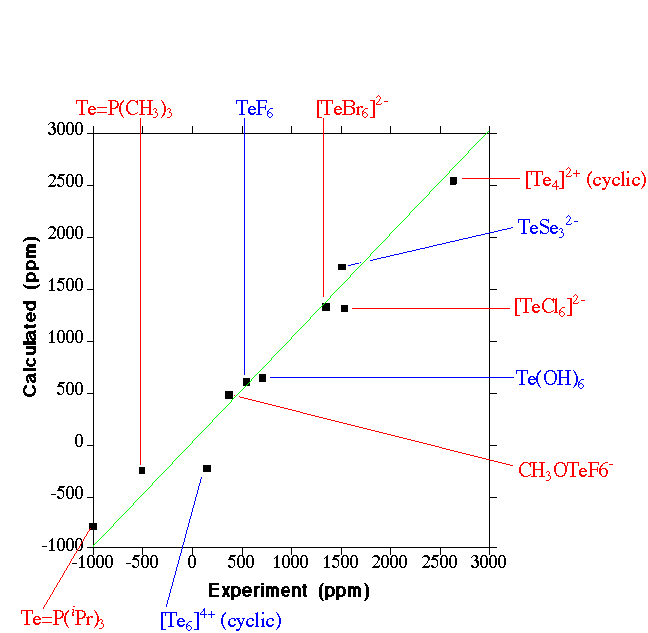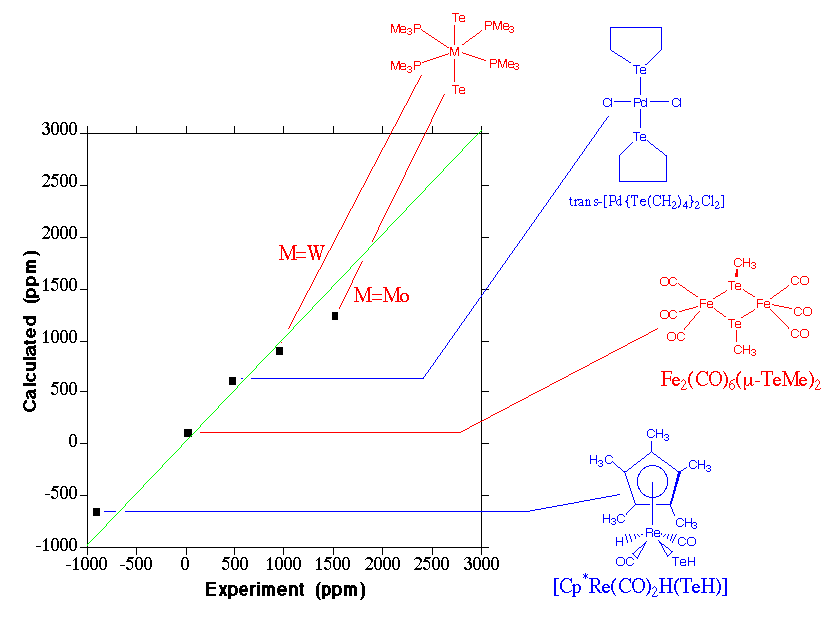
(Y. Ruiz-Morales, G. Schreckenbach, T. Ziegler, J. Phys. Chem. A 1997, 101, 4121-4127)
The theoretical determination of 125Te NMR chemical shifts is a very challenging task since both electron correlation
and relativistic effects will play a major role. Further, the size of these
systems can be considerable, see the figures below for some examples. Hence, 125Te NMR is a powerful example to illustrate the capabilities of modern first
principle density functional theory (DFT) as applied to magnetic properties.
The three pictures show results from our recent relativistic DFT-GIAO ("gauge including atomic orbitals") calculations [J. Phys. Chem. A 1997, 101, 4121-4127].
Some of the remaining differences between theory and experiment have been
attributed to solvent effects and ro-vibrational corrections, the latter
being due to finite temperatures in the experimental setting. (The theoretical
model is based on the usual Born-Oppenheimer approximation, i.e., a single,
ridgid molecule. This situation is closest described by the zero-temperature,
zero-pressure limit of a gas phase NMR experiment.)
Chemical shifts are given in ppm relative to dimethyltellurium, (CH3)2Te, the experimentally accepted standard.

Figure 1.
Calculated and experimental 125Te chemical shifts of organic tellurium compounds. The average deviation
between theory and experiment is 235 ppm. The calculated chemical shifts
span a range of about 3000 ppm which covers almost the entire known chemical
shift range for the 125Te nucleus. Note the size of some of the molecules.

Figure 2.
Calculated and experimental 125Te chemical shifts of inorganic tellurium compounds. The average deviation
between theory and experiment is 160 ppm. The calculated chemical shifts
span a range of about 3400 ppm which covers almost the entire known chemical
shift range for the 125Te nucleus.

Figure 3.
Calculated and experimental 125Te chemical shifts of organometallic tellurium compounds. The average deviation
between theory and experiment is 155 ppm. The calculated chemical shifts
span a range of about 2400 ppm. Note the size these complexes. While relativistic
effects are already important for a correct description of 125Te NMR in general, they are crucial for complexes of 5d elements like tungsten.
![]() Back to Georg's Home Page
Back to Georg's Home Page
Back to Georg's Publications
Back to Research Page
© Georg Schreckenbach, 1997-2001